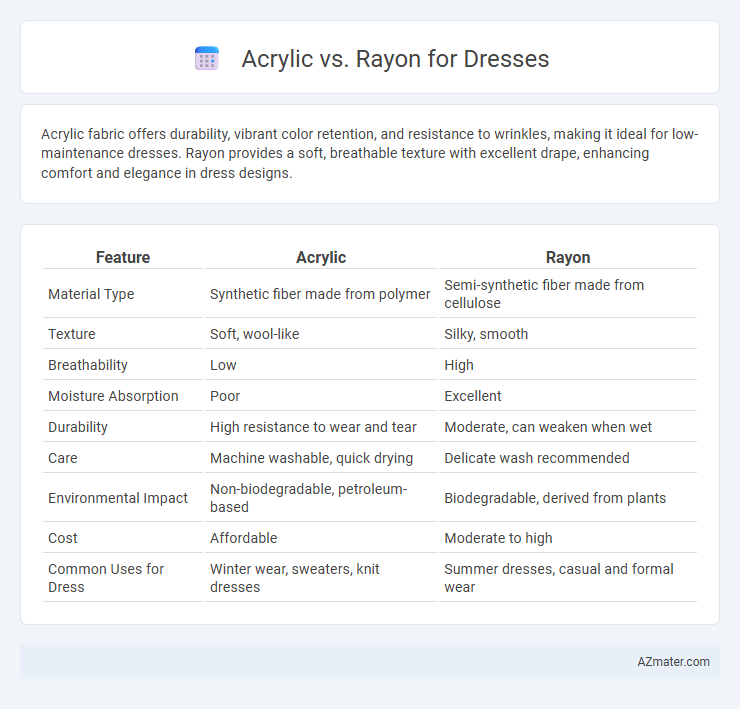Acrylic fabric offers durability, vibrant color retention, and resistance to wrinkles, making it ideal for low-maintenance dresses. Rayon provides a soft, breathable texture with excellent drape, enhancing comfort and elegance in dress designs.
Table of Comparison
| Feature | Acrylic | Rayon |
|---|---|---|
| Material Type | Synthetic fiber made from polymer | Semi-synthetic fiber made from cellulose |
| Texture | Soft, wool-like | Silky, smooth |
| Breathability | Low | High |
| Moisture Absorption | Poor | Excellent |
| Durability | High resistance to wear and tear | Moderate, can weaken when wet |
| Care | Machine washable, quick drying | Delicate wash recommended |
| Environmental Impact | Non-biodegradable, petroleum-based | Biodegradable, derived from plants |
| Cost | Affordable | Moderate to high |
| Common Uses for Dress | Winter wear, sweaters, knit dresses | Summer dresses, casual and formal wear |
Introduction to Acrylic and Rayon Fabrics
Acrylic fabric, a synthetic fiber derived from polymer-based compounds, is known for its wool-like feel, durability, and resistance to wrinkles and fading, making it a popular choice for affordable, low-maintenance dresses. Rayon, a semi-synthetic fiber produced from regenerated cellulose, offers a soft, breathable texture with excellent draping qualities and moisture absorption, enhancing comfort and flow in dress designs. Both fabrics serve distinct aesthetic and functional purposes, with acrylic favoring longevity and vibrant color retention, while rayon emphasizes natural feel and breathability.
Composition and Manufacturing Process
Acrylic is a synthetic fiber made from polymer compounds derived from acrylonitrile through a process called polymerization, resulting in a lightweight, wool-like texture often used in dress fabrics for its durability and resistance to wrinkles. Rayon, a semi-synthetic fiber, is produced from regenerated cellulose fibers extracted from wood pulp or cotton linters through chemically intensive shaping and spinning processes, creating a soft, breathable fabric that mimics natural fibers like silk or cotton. The primary difference lies in acrylic's petroleum-based origins and synthetic nature, while rayon's cellulose base involves organic raw materials and extensive chemical treatment to achieve its fiber form.
Texture and Appearance Comparison
Acrylic fabric offers a soft, wool-like texture with a matte finish, making it ideal for lightweight, warm dresses that retain shape and resist wrinkles. Rayon, derived from natural cellulose fibers, provides a smooth, silky texture with a lustrous sheen that drapes elegantly, enhancing the dress's flow and vibrancy. While acrylic tends to have a coarse feel and less breathability, rayon excels in softness and breathability, contributing to a more luxurious and comfortable appearance in dress fabrics.
Breathability and Comfort
Acrylic fabric tends to be less breathable than rayon, often trapping heat and moisture, which can reduce overall comfort in dresses worn for extended periods. Rayon, derived from natural cellulose fibers, offers superior breathability and a soft, lightweight feel, making it ideal for warm-weather clothing. Choosing rayon enhances airflow and moisture-wicking properties, resulting in increased comfort and a cooler wearing experience.
Durability and Longevity
Acrylic fabric offers excellent durability and resists wear, making it ideal for long-lasting dresses that maintain shape and color over time. Rayon, while softer and more breathable, tends to be less durable due to its natural fiber composition, often showing signs of wear and pilling sooner. For dress longevity, acrylic's resistance to moisture and UV damage ensures extended lifespan compared to rayon's more delicate maintenance requirements.
Care and Maintenance Requirements
Acrylic dresses require low maintenance, being resistant to wrinkles and shrinking, and can be machine-washed on gentle cycles with cold water, though air drying is recommended to prevent heat damage. Rayon dresses demand more delicate care, often needing hand washing or dry cleaning as they are prone to shrinking and losing shape when exposed to excess moisture or agitation. Proper care ensures longevity for both fabrics, with acrylic offering convenience and rayon requiring more attention to maintain its luxurious feel and drape.
Affordability and Availability
Acrylic fabric offers significant affordability compared to rayon, making it a popular choice for budget-conscious dressmakers and consumers. Rayon, while slightly pricier, is widely available but often found in specialty or higher-end markets due to its semi-synthetic origins and manufacturing complexity. Both materials are accessible worldwide, but acrylic's lower production cost ensures greater availability in mass-market apparel shops and online retailers.
Environmental Impact
Acrylic fibers, derived from synthetic polymers, contribute significantly to microplastic pollution and are non-biodegradable, posing long-term environmental challenges when used in dress fabrics. Rayon, produced from regenerated cellulose fibers sourced from wood pulp, is biodegradable but its environmental impact varies greatly depending on the manufacturing process, with eco-friendly methods using sustainably harvested wood and closed-loop production systems reducing chemical waste. Choosing rayon dresses made through sustainable practices offers a lower environmental footprint compared to traditional acrylic dresses, emphasizing the importance of fiber origin and processing in assessing ecological impact.
Best Uses for Dresses
Acrylic fabric offers a lightweight, wrinkle-resistant option ideal for casual and winter dresses due to its warmth and durability. Rayon provides a soft, breathable, and drape-friendly material perfect for flowy, elegant dresses suited for warmer weather or special occasions. Choosing between acrylic and rayon depends on desired dress style, comfort, and seasonal wear.
Choosing the Right Fabric for Your Needs
Acrylic fabric offers durability, wrinkle resistance, and warmth, making it ideal for affordable, easy-care dresses suitable for cooler weather. Rayon provides breathability, softness, and a luxurious drape, perfect for lightweight, comfortable dresses in warm climates or formal occasions. Selecting between acrylic and rayon depends on your priorities for comfort, maintenance, and climate suitability in your dress choice.

Infographic: Acrylic vs Rayon for Dress
 azmater.com
azmater.com